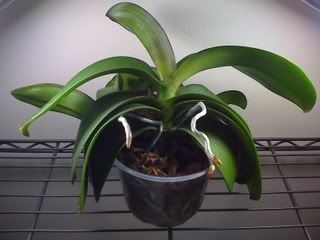
Some things you may find on Phalaenopsis leaves are black spots, dry brown spots, yellow patches, or sticky, amber-colored honeydew. Black spots are an indication of a bacterial infection, usually caused by physical wounds that were contaminated in some way. These black spots should be cut out, or off, with sterile utensils and treated with cinnamon or a fungicide. Dry brown spots are usually a symptom off too much sun. If a portion of the leaf appears to have died and turned brown, that is scorching. You do not need to remove this from the leaf, but you should probably move your plant to a shadier area.
Yellowing of the leaves can mean one of three things: If it is the bottom-most leaf, and is yellowing uniformly, it is probably just normal aging and you need not be concerned. If it is an upper leaf, it depends on whether the yellowing is coming from the outer edge of the leaf or from the part of the leaf connected to the plant. If it is the leaf tip, over-fertilization is the likely cause. If it is coming from the part of the leaf attached to the plant, or from the center of the leaf outward, your plant has probably been over-watered and is rotting.
Sticky, amber-colored goo is a sign of scale infestation. Scale is the most common pest to Phalaenopsis, and they must be washed off by hand, preferably with an insecticidal soap. Repeat washings once a week for 4 weeks. Other, much more infrequent pests can include mealy bug or spider mites.
Hopefully, by sharing what I have learned through trial and error, your orchid-growing experience will be more of a pleasure. All Phalaenopsis ask for is a little attention at the start. Once you have grown to know them, they will be thankful for just an occasional minute of your time.


